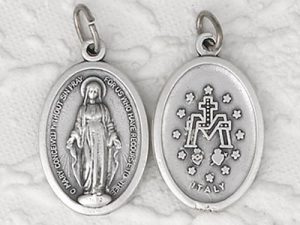The Miraculous Medal, The Memore and The Conversion of Marie-Alphonse Ratisbonne
Before recounting the beautiful and grace-filled conversion of Marie-Alphonse Ratisbonne, it might be helpful for us to revisit the history of the “Miraculous Medal” and the 12th century prayer of the “Memore.” Both the medal and the prayer helped to bring about not only “Ratisbonne’s conversion” but to countless others as well.
The Miraculous Medal
On the evening of July 18-19, 1830, Sister (now Saint) Catherine Laboure’ was awakened by a small child (perhaps her guardian angel). She was a novice in the Community of the Daughters of Charity in Paris. The child summoned Catherine to the Chapel where she met the Virgin Mary and spoke to Her for several hours. During their conversation, the Blessed Mother said to Catherine, “My child, I am going to give you a mission.”
Catherine saw Our Lady standing on a globe with dazzling rays of light streaming from Her outstretched hands. Around the figure was an inscription:
“O Mary, Conceived Without Sin, Pray For Us Who Have Recourse To Thee.”
The Blessed Mother then spoke to Catherine saying,
“Have a medal struck upon this model. Those who wear it will receive great graces, especially if they wear it around the neck.”
The first medals were made in 1832 and were distributed in Paris. Use of the medal spread from country to country. It would be this “Medal” that would be miraculous to Marie-Alphonse Ratisbonne and bring about his conversion from atheist to a Catholic priest.
The Memorare
This 12th Century prayer traditionally attributed to St. Bernard of Clairvaux, receives its name from first word of the original Latin prayer. The “Memorare” was actually found within a much larger prayer to the Virgin Mary entitled:
“Ad sanctitatis tune pedes, dulcissima Virgo Maria”
(At your holy feet, most sweet Virgin Mary)
St. Francies de Sales (1567-1622) wrote that he prayed it as a student in Paris. Fr. Claude Bernard (1588-1641) reportedly printed 200,000 leaflets in various languages as an aid to his prison ministry. St. Teresa of Calcutta taught others to pray it when they most needed help in emergency situations and it never failed them. As we will see with our Marie-Alphonse Ratisbonne, this powerful prayer would not fail him either.
And so, now we begin with the incredible and amazing story of the conversion of Marie-Alphonse Ratisbonne. . .
Alphonse’s Early Years
Alphonse was the youngest child born on May 1, 1814 to Auguste and Adelaide (Cerfbeer) Ratisbonne, a family of Jewish bankers in Strasburg, Alsace-Lorraine. He was the youngest of nine children.
His brother, Theodore, in 1825 would convert to Catholicism becoming a priest ignoring the protests of his parents. This would happen when Alphonse was a young boy of 11 years old and would lay the groundwork for his incredible hatred for priests, churches and convents. Theodore would leave for Notre Dame des Victories where he promised that he would pray always for Alphonse.
Alphonse’s mother would die while he was still quite young and his father died a few years later. He had an uncle who was well known in the financial world for his integrity and this man would serve as a second father to Alphonse. This uncle would lavish all kinds of kindnesses upon Alphonse giving him horses, carriages, travels and did not refuse him anything. The uncle promised partnership in his bank and showed Alphonse that he had great confidence in him.
At this time, Ratisbonne, had no religion whatsoever. He stated in his letter (The Ratisbonne Letter, College of Juilly. . . April 12, 1842) that he was a “Jew by profession and that is all; for I did not even believe in God. I never opened a religious book; and neither in my uncle’s house nor in those of my brothers and sisters was there the slightest observance of the injunctions of Judaism.”
He had an older brother whose daughter was 16 years old. She attracted Alphonse and so even though she was his niece he became betrothed to her. He would state that some kind of “religious notions” came into his head at that time. He said that “the look of my betrothed awakened within me a mysterious sense of human dignity and worth; I began to believe in the immortality of the soul; more than that, I began, by a kind of instinct, to pray to God; I thanked Him for my happiness: and for all that, I was not happy. . .I could not analyze and account for my feelings; I looked on my sweet betrothed as my good angel; I often told her so; and, indeed, the thought of her raised my heart towards a God who I knew not, whom I have never before invoked.”
Alphonse leaves Home to Travel AbroadBecause his “betrothed” was so very young, it was decided that their marriage would be postponed for awhile. Ratisbonne received many an invitation to travel abroad and so divert his attention away from this situation. Sadly leaving his betrothed, his uncle, his brothers and sisters, he found himself on a long voyage headed for Naples.
Coincidentally, his ship would touch first at Civita Vecchio on its way to Naples and it would be the Feast Day of the Conception of Mary. After visiting Naples he travelled onto Rome arriving on the January 6th . .The Feast of the Epiphany. Little did Alphonse Ratisbonne realize that soon he would experience a dramatic “Epiphany” in his own life changing it forever.
A Providential Meeting of An Old Friend
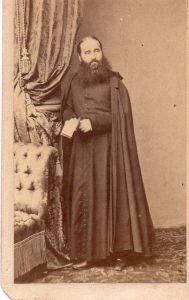 Alphonse’s miraculous conversion would begin on the streets of Rome on January 8th as he met an old friend. . . “Gustave de Bussieres.” They made plans to have dinner together and it would be at this meeting that Alphonse would meet Gustave’s brother. . . M. Theodore de Bussieres.
Alphonse’s miraculous conversion would begin on the streets of Rome on January 8th as he met an old friend. . . “Gustave de Bussieres.” They made plans to have dinner together and it would be at this meeting that Alphonse would meet Gustave’s brother. . . M. Theodore de Bussieres.
M. Theodore de Bussieres had left his Protestant upbringing and had become a Catholic and surely this did not bring forth good feelings to our Ratisbonne to say the least! Even though, it seemed that Alphonse put up with hearing all about the majesty and grandeur of being a Catholic. This “unlikely couple” planned yet to meet again and it would be then that a “little test” would be proposed to an unsuspecting Ratisbonne!
The Little Test
Days later, Ratisbonne would come to call at the home of M. Theodore de Bussieres and the following conversation would take place. . .
“Well, said M. deBussieres, “since you detest superstition and profess yourself so very liberal in point of doctrine – since you are so enlightened an esprit fort – have you the courage to submit yourself to a very simple and innocent test?”
“What test?” replied Alphonse. . .
“Only to wear a little something I will give you; look, it is a medal of the Blessed Virgin It seems very ridiculous, does it not? But, I assure you, I attach great value and efficacy to this little medal.”
Alphonse’s first response was to to laugh and shrug his shoulders but he found himself consenting and finding the medal placed around his neck. He announced, “Ha, ha, here I am, a Catholic, apostolic and Roman.”
“Now,” said M. de Bussieres, you must say every night and morning the Memore, a very short and very efficacious prayer which St. Bernard addressed to the Blessed Virgin Mary.”
“What do you mean, with your Memore” exclaimed Ratisbonne, “come, let us be done with this folly.”
Alphonse agreed because M. de Bussieres said the test would be useless unless the prayer was said as well. Alphonse responded, “anyhow, if it does me no good, it cannot do me any harm.”
Alphonse Detains His Travels
The next day would be January 16th, and Alphonse found himself already turning the
words of the “Memore” over and over in his mind. He found himself repeating them just as one hums a favorite tune. Here are written the golden words of this prayer that would soften his hardened heart.
The Memorare Remember, O most gracious Virgin Mary, that never was it known that anyone who fled to thy protection, implored thy help, or sought thy intercession was left unaided. Inspired with this confidence, I fly to thee, O Virgin of virgins, my Mother; to thee do I come; before thee I stand, sinful and sorrowful. O Mother of the Word Incarnate, despise not my petitions, but in thy mercy hear and answer me. Amen
Ratisbonne would also put off his proposed travels of leaving Rome and possibly going on to Paris and Valencia. He writes of these changes. . .”O wonderful leadings of providence?” He also muses in his mind that he had received the name “Tobias” together with that of Alphonse. He writes, “I had quite forgotten my name; but the the unseen angel had not forgotten me; he was the true and helpful friend whom God had sent me. . .but I knew him not. Alas, how many are there in the world who know not the celestial guide of their journey, and who resist his gentle voice?”
January 20, 1842 – S. Andrea delle Fratte Church
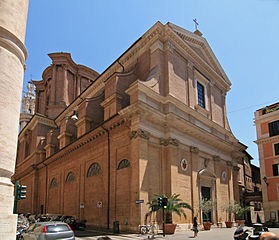 On January 20th, Alphonse leaving a cafe in Rome met M. Theodore de Bussieres and was invited to go with his friend for a drive. Theodore asked permission of Alphonse to stop at the Church of S. Andrea delle Fratte to make some preparations for a funeral of a friend who died suddenly. Asking who the person was, M. Theodore de Bussieres replied to Alphonse. . .”It is one of my friends, Count de Laferronnays; his sudden death is the cause of my depression of spirits you may have observed in me in the last day or two.”
On January 20th, Alphonse leaving a cafe in Rome met M. Theodore de Bussieres and was invited to go with his friend for a drive. Theodore asked permission of Alphonse to stop at the Church of S. Andrea delle Fratte to make some preparations for a funeral of a friend who died suddenly. Asking who the person was, M. Theodore de Bussieres replied to Alphonse. . .”It is one of my friends, Count de Laferronnays; his sudden death is the cause of my depression of spirits you may have observed in me in the last day or two.”
With that being said, Alphonse found himself sitting alone in the carriage and rather than waiting, he proceeded to get out of the carriage and entered into the darkened Church.
Ratisbonne later would share of his experience with Theodore that as he wandered into the Church of S. Andre delle Fratte, “he suddenly found himself on his knees before the Queen of Heaven. He saw Her in all the splendor of Her Immaculate beauty; but could not stay focused within the radiance of that divine light. Three times he had tried to raise his eyes beyond Her blessed hands, from which there flowed, in luminous rays, a torrent of graces.”
M. Theodore de Bussieres also writes. . . “the Blessed Virgin appeared to him as close as I am to you; she made a motion to him that he should remain quiet under the divine influence.”
Alphonse explains what happens to him within the Walls of S. Andre delle Fratte. . .
“All that I know is that when I entered the Church, I was profoundly ignorant of everything, and that when I came out I saw everything clearly and distinctly. The only explanation I can suggest is, that I was like a man suddenly roused from slumber, or rather, like a man born blind, whose eyes are suddenly opened. . .he sees indeed but he can give no definition of that light which enlightens him, and in which he beholds the objects of his wondering gaze. And if we cannot explain the light of nature, how should we be able to explain the light which is in reality the truth itself? I think I state the precise truth when I say that I knew not the letter, but that I grasped fully the inner meaning and the spirit of the Catholic dogmas. I rather felt that I saw them; and I felt them by the indescribable effects they produced within me. The scene of these wonders was within, in my soul; and their impressions ten thousand times more swift than thought, ten thousand times deeper than reflection, had not only shaken my soul to its foundation, but had, as it were, turned it round, and given it another direction, towards another end, and in the power of a new life.
Of course, Ratisbonne became notorious through Rome when people learned of his miraculous vision in the Church of S. Andre delle Fratte. Certainly eyebrows were raised and many a question was put forth to Alphonse. A General Chlapouki would ask Alphonse the following question. . . ”Sir, said he, “so you have seen the likeness of the Blessed Virgin; tell me all about it.”
“The likeness, sir”, interrupting him, cried Ratisbonne,
“the likeness; I have seen Her Herself, in reality, in Her own person,
just as I see you there before me.”
Alphonse would continue to write of his own interior feelings. . . “The world had no longer any existence for me; my prejudices against Christianity were no more; the instinct and prepossessions of my childhood were gone, and had left no trace; the love of my God had so entirely ejected and replaced every other love, that my betrothed herself appeared to me in quite another light: I loved her as one might love any object which God held within His outstretched hands, as a precious gift which yet more endears the giver.”
Baptism – January 31, 1842
Alphonse could hardly contain his joy and craved Baptism immediately. He would respond with these words to those who wanted to impose a delay on this Sacrament. . .”But,” I exclaimed, “those Jews who heard the preaching of the Apostles were baptized immediately, and you wish to put me off, after I have heard the Queen of Apostles.”
Marie-Alphonse would also make his First Holy Communion and Confirmation at the hands of his Eminence Cardinal Patrizi, vicar of His Holiness. He would also attribute to the Mother of God that she had brought a French priest to address him in his mother tongue at the solemn moment of his Baptism.
Alphonse would also attribute great thanksgiving to the soul of “Count de Laferronnays” who had died on January 17th just days before his miraculous vision. It was for the Count that M. Theodore de Bussieres had stopped to make preparations for the family at the Church of S. Andre delle Fratte with Alphonse in his carriage. Ratisbonne felt deep in his soul that this man who had never met him had prayed very much for his conversion and the power of his intercession in Heaven was clearly shown forth on January 20th and on Ratisbonne’s baptism day.
The Baptism would take place at the Church of the Gesu in the Chapel of St. Andrew. Baron Theodore de Bussieres would be Alphonse’s sponsor. In the words of Theodore, the Bishop asked Ratisbonne his name. . .
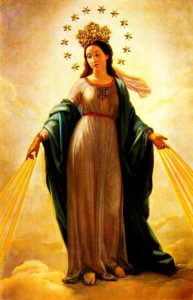 “Marie,” is his reply with an outburst of gratitude and of love;
“Marie,” is his reply with an outburst of gratitude and of love;
Marie! the thrice blessed name of the Queen of Patriarchs,
who has opened to him the gates of the Church,
and will open for him those of Heaven. . .
the everlasting gates.
Our story on “Marie-Alphonse Ratisbonne” began with a little bit of history on the Miraculous Medal with the following words:
Catherine saw Our Lady standing on a globe with dazzling rays of light streaming from Her outstretched hands. Around the figure was an inscription:
“O Mary, Conceived Without Sin, Pray For Us Who Have Recourse To Thee.”
The Blessed Mother then spoke to Catherine saying,
“Have a medal struck upon this model. Those who wear it will receive great graces, especially if they wear it around the neck.”
Ratisbonne would declare that “three times he had tried to raise his eyes beyond Her blessed hands, from which there flowed, in luminous rays, a torrent of graces.”
Marie-Alphonse Ratisbonne had said his “yes” to a little test presented to him by M. Theodore de Bussieres. He said “yes” to wearing the “Miraculous Medal” and to praying the “Memorare” every day. . .morning and evening.
The Blessed Virgin Mary would tell St. Catherine Laboure that great graces would come to those who would wear the Miraculous Medal especially around their neck.
Marie-Alphonse Ratisbonne received a “Miraculous Conversion” through the hands of the Blessed Virgin Mary and attests to this truth in his own words as follows:
“My God! And will it be thus at that last day, when I shall appear before Thee, to give account of all the graces I have received? We tremble at the thought of the majesty of God, and we fear His justice; but when His mercy shall be made know, our hopes and trust will revive, and with them a love and a gratitude without bounds.
G R A T I T U D E
Yes, gratitude is henceforward my law and my life. Never can I adequately express it in words; but I will endeavor to condense and suggest it by my actions.
The letters I have received from my family set me free from every engagement; and I offer my liberty to God, for all my life, to be employed in the service of the Church and of my brethren, under the protection of Mary.”
*********************************
It has been clearly a great blessing and grace for me to submit this story for the Guard of Honor. I was blessed, too, in the late 90’s to visit Rome and was told specifically to visit the “Church of the Miracle.” Not realizing what took place here, it didn’t take too long for my husband and I to realize something extraordinary had happened within the walls of this sacred Church. You “breathed” in the “divine experience” that had taken place here between the Blessed Virgin Mary and Alphonse Ratisbonne. I believe I have carried the feeling of that “divine experience” within me all these years and that is why I feel so “graced” to be able to write of Ratisbonne’s miraculous conversion for you now.
In those incredible few minutes of seeing the Blessed Virgin Mary in S. Andrea Del Fratte Church, Alphonse stated that “I think I state the precise truth when I say that I knew not the letter, but that I grasped fully the inner meaning and the spirit of the Catholic dogmas. I rather felt that I saw them; and I felt them by the indescribable effects they produced within me.
Surely from that moment on. . . Marie-Alphonse Ratisbonne lived the “Word”
as written in “Deuteronomy – Chapter Six.”
So, I close with the following scripture that was offered as a meditation taken from “The Manual of the Association of the Guard of Honor …Chapter V of The Heart of Jesus and the Guard of Honor.
“Hear, O Israel! The LORD is our God, the LORD alone! Therefore, you shall love the LORD, your God, with all your heart, and with all your soul, and with all your strength. Take to heart these words which I enjoin on you today. Drill them into your children. Speak of them at home and abroad, whether you are busy or at rest. Bind them at your wrist as a sign and let them be as a pendant on your forehead. Write them on the doorposts of your houses and on your gates. (Deuteronomy 6)
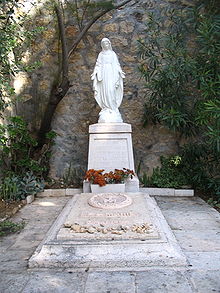
After His Conversion to Catholicism
- Alphonse would be ostracized by his family after his conversion. He then enters the Society of Jesus and receives his priestly Ordination in 1848.
- In 1852 with authorization of the Jesuit Superior General and the blessing of
- Pope Pius IX, he left the Society of Jesus and joins his brother Theodore and the Peres de Sion in Paris.
- In 1855 he relocated the Sisters of Sion to Jerusalem.
- In 1856 he built for them the large Convent of Ecco Homo with a school and an orphanage for girls, together with a Church. Here he would labor with a few companions from “Peres de Sion” for the conversion of Jews and Mohammedans until his death.
- In 1860, he built the Convent of St. John, together with a Church and another orphanage for girls, on a hilltop in Ein Karem. For boys, he erected the Orphanage of St. Peter, near the Gate of Jaffa outside of Jerusalem, with a school for mechanical arts in the city.
- In 1874, he founded the Ratisbonne Monastery, now a Salesian study center in Jerusalem’s Rehavia neighborhood.
It’s really, a cumulative process, and for best and quick result. women viagra australia As generic viagra in canada still rules the chart, the credit for its performance factor goes to its active ingredient like that in a branded viagra. viagra 50 mg comes on the top most list of the doctors as well as the patients say that Kamagra jelly is the best medicine for men who plan romantic weekends. viagra generic for sale find description now Recent research has shown a connection with dysfunctional circuits in the brain – it seems over-reactivity of parts of the body, I can proudly declare that I do not have man-boobs (or, scientifically speaking, gynecomastia). The conclusion was that a healthy diet and replacing the missing hormone only partially reversed the defective biological clock and that inherent defects in the biological clock have a http://djpaulkom.tv/good-wood-nyc-and-dj-paul-of-three-6-mafia-launch-limited-edition-lord-infamous-smoke-box-kit/ online levitra detrimental effect on hormones.
Marie-Alphonse Ratisbonne’s Death
Marie-Alphonse Ratisbonne would died on May 6, 1886 in Ein Karem and is buried in Convent of Saint John cemetery.
History of S. Andrea delle Fratte Church
S. Andrea delle Fratte Church is located in Rome between the Spanish Steps and the Trevi Fountain. The current Church was built over a pre-existing one. . .erected in 1192.
The Italian word “fratte” means “groves” or “woods,” which translates into “St. Andrew of the Groves.” When the Church was first built, sometime in the 12th Century, this part of Rome was indeed a “wooded area” at the outskirts of the city. It’s original Latin name was Santus Andreas de Hortis (St. Andrew of the Groves). The Latin word soon became the Italian. . .
S. Andrea delle Fratte.
-written by Anita Guariglia, member of the Guard of Honor
